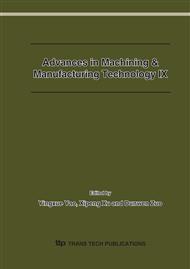p.107
p.113
p.118
p.123
p.128
p.133
p.138
p.143
p.148
Development of Self-Toughening Silicon Nitride Matrix Nanocomposite Ceramic Tools and Cutting Performance
Abstract:
A series of self-toughening silicon nitride matrix nanocomposite ceramic tool materials are fabricated by hot-press technology at different sintering processes. And their microstructure has been observed and analyzed by a scanning electron microscope (SEM). Finally, the tests of mechanical properties and the cutting performance of the new ceramics are presented. The research results showed that the nanocomposite ceramic tool materials GGW20T5 and GGW20TC25 have better mechanical properties and possess a stronger wear resistance in cutting 40Cr alloy steel.
Info:
Periodical:
Pages:
128-132
Citation:
Online since:
March 2008
Authors:
Keywords:
Price:
Сopyright:
© 2008 Trans Tech Publications Ltd. All Rights Reserved
Share:
Citation:


